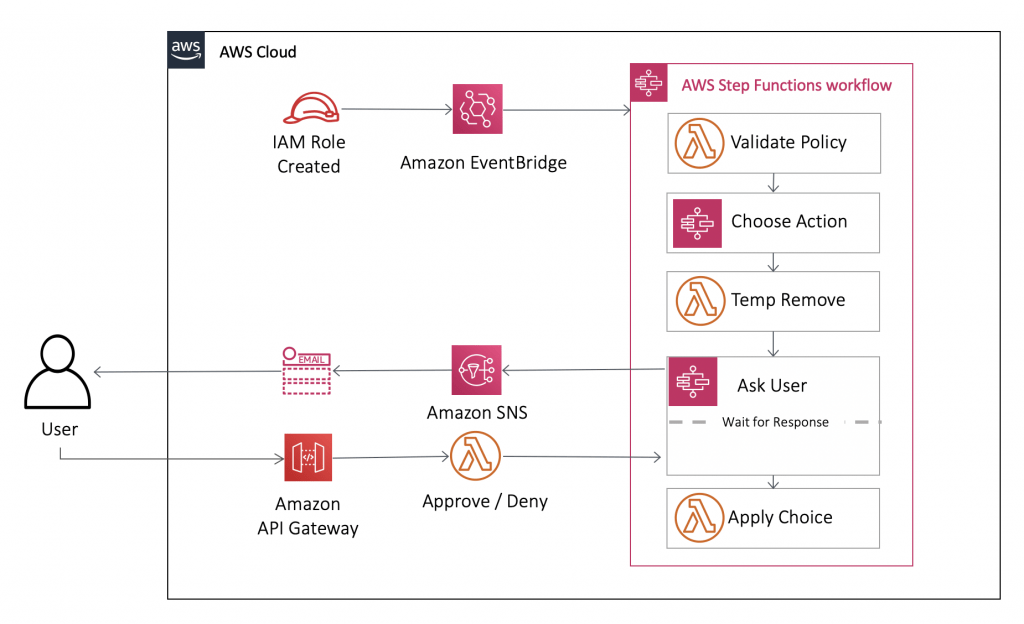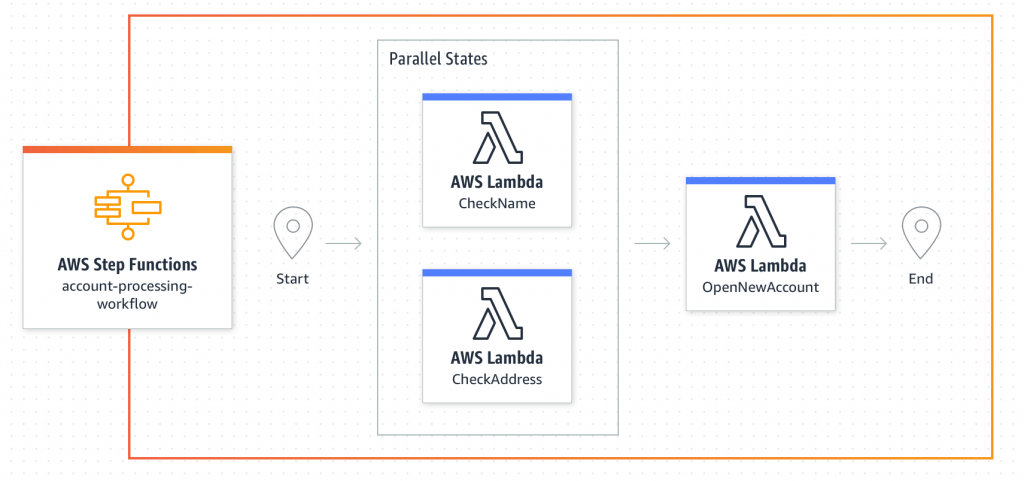
- Introduction to AWS Step Functions
- Key Features of AWS Step Functions
- Benefits of Using AWS Step Functions
- How AWS Step Functions Work
- Setting Up AWS Step Functions
- Integrating AWS Step Functions with Other AWS Services
- AWS Step Functions vs. Traditional Workflow Management
- Use Cases of AWS Step Functions
- Security and Compliance in AWS Step Functions
- Pricing and Cost Management
- Common Challenges and How to Overcome Them
- Conclusion
Introduction to AWS Step Functions
AWS Step Functions is a fully managed, serverless orchestration service provided by Amazon Web Services that enables developers to design and coordinate workflows consisting of multiple AWS services. These workflows, referred to as state machines, are built from a series of steps, each representing a task that performs a specific function, such as calling AWS Lambda functions, interacting with Amazon S3, Amazon Web Services Certification or invoking other services like DynamoDB or SNS. AWS Step Functions simplifies the process of building and managing complex, distributed applications by enabling seamless communication between components, services, and systems, while abstracting away the infrastructure management overhead. The service allows developers to easily define, execute, and monitor workflows using a JSON-based Amazon States Language (ASL) or a visual interface. One of the key benefits of AWS Step Functions is its ability to handle failures, retries, and parallel execution, making workflows more resilient and fault-tolerant. Additionally, the service supports both synchronous and asynchronous execution models, allowing for flexibility in how workflows are designed and executed.
Key Features of AWS Step Functions
-
AWS Step Functions offers a rich set of features that simplify the orchestration of complex workflows:
- Visual Workflow Creation: Provides a graphical console to design, visualize, and manage workflows.
- Serverless Execution: Automatically manages infrastructure, scaling, and execution.
- Built-in Error Handling: Includes retry policies, catchers Amazon Web Services, and timeouts.
- Integration with AWS Services: Seamless integration with services like AWS Lambda, EC2, S3, and DynamoDB.
- State Management: Maintains state across steps, ensuring data consistency.
- Support for Parallel Execution: Allows concurrent processing of tasks to improve performance.
- Audit and Logging: Integrated with AWS CloudWatch for monitoring and logging.
Benefits of Using AWS Step Functions
One of the primary benefits of AWS Step Functions is the simplification of complex workflows. Developers can break down complicated processes into manageable steps, each performing a specific function. This modular approach improves maintainability and reduces the likelihood of errors. Amazon Web Service Course advantage is the built-in fault tolerance. AWS Step Functions automatically retries failed tasks and provides mechanisms for error handling, ensuring that workflows continue to operate smoothly even when issues arise. This enhances the reliability and resilience of applications. Moreover, the serverless nature of AWS Step Functions eliminates the need for manual infrastructure management. This allows developers to focus on building and optimizing applications without worrying about underlying resources.
Are You Interested in Learning More About AWS ? Sign Up For Our AWS Online Training Today!
How AWS Step Functions Work
AWS Step Functions operate by defining workflows as state machines, where each state represents a specific step in the process. Here’s how it works:
- Define the Workflow: Create a state machine using Amazon States Language (ASL), a JSON-based language for defining workflows.
- Specify States and Transitions: Define states, their functions, and how they transition to the next step.
- Trigger Execution: Start the workflow Exploring AWS Applications execution via API calls, AWS Lambda, or other triggers.
- Monitor Execution: Use the visual console or CloudWatch for real-time monitoring and debugging.
- Handle Errors: Implement retry mechanisms and catchers for error handling.

Setting Up AWS Step Functions
Setting up AWS Step Functions is straightforward and can be done through the AWS Management Console, AWS CLI, or SDKs. To get started, log in to the AWS Management Console and navigate to the Step Functions service. Click on “Create state machine” and choose either the standard or express workflow type. Define your workflow using the visual editor or by uploading an Amazon States Language (ASL) JSON file. Once your workflow is defined, configure the necessary permissions and roles, then start the execution to see your workflow in action. You can monitor the progress and outcomes using the visual console.
Integrating AWS Step Functions with Other AWS Services
AWS Step Functions can be seamlessly integrated with a variety of AWS services to build powerful, end-to-end workflows:
- AWS Lambda: Execute serverless functions within your workflow.This allows you to run custom code without managing servers, providing a flexible and scalable solution to perform specific tasks within workflow.
- Amazon S3: Trigger workflows based on S3 events or manipulate S3 objects, such as automatically resizing images, processing data, or sending notifications when objects are created or modified.
- Amazon DynamoDB: Read from and write to DynamoDB tables as part of the workflow. By incorporating DynamoDB, you can manage stateful data, Understanding AWS Big Data update records, or trigger further actions based on database operations within your workflow.
- Amazon SNS & SQS: These services enable asynchronous communication, allowing workflows to trigger notifications or interact with other systems without blocking the execution of tasks.
- AWS Glue: Integrate ETL processes into your workflows. AWS Glue allows you to automate data transformation tasks, simplifying data processing and ensuring smooth integration of ETL operations within your workflow pipeline.
- Microservices Orchestration: Coordinate multiple microservices for complex applications. This allows for seamless communication and orchestration between independently deployed microservices, ensuring high availability and scalability.
- ETL Pipelines: Automate data extraction, transformation, and loading processes. With AWS Step Functions, you can manage data flow across various services like Amazon S3, Lambda, and Redshift, ensuring efficient and fault-tolerant ETL operations.
- Machine Learning Workflows: Orchestrate Introduction to Amazon API Gateway data preprocessing, model training, and deployment. It simplifies the coordination of machine learning stages, from data collection to model optimization and deployment to production, ensuring a smooth end-to-end pipeline.
- Batch Processing: Manage large-scale batch jobs with error handling and retries. By automating retries and parallel execution, AWS Step Functions ensure that large datasets are processed reliably and efficiently without manual intervention.
- IoT Applications: Coordinate IoT device data processing and analysis workflows. AWS Step Functions enable the seamless integration of IoT data processing, real-time analytics, and cloud storage to derive actionable insights from IoT devices.
- Business Process Automation: Streamline business workflows such as order processing and inventory management. Automating manual tasks and approvals in business workflows improves operational efficiency and reduces the likelihood of human error in day-to-day operations.
- Complexity in Large Workflows: Managing very large workflows can become complex.
- Solution: Break down workflows into smaller, modular state machines. This modular approach improves maintainability and reduces the cognitive load when managing workflows.
- Limited Debugging Tools: Debugging failed workflows can be challenging.
- Solution: Use CloudWatch Logs and detailed error messages to troubleshoot issues. Additionally, integrating with X-Ray can help provide deeper insights into the flow and pinpoint issues with greater accuracy.
- Cost Management: Unexpected costs due to frequent state transitions.
- Solution: Regularly review and optimize workflows to minimize transitions. Implementing batching or conditional logic to reduce redundant transitions can further help in cost optimization.
To Earn Your End to End Encryption Certification, Gain Insights From Leading End to End Encryption Experts And Advance Your Career With ACTE’s AWS Online Training Today!
AWS Step Functions vs. Traditional Workflow Management
When comparing AWS Step Functions to traditional workflow management tools, several differences become apparent. Traditional workflow tools often require manual setup and management of infrastructure, which can be time-consuming and error-prone. In contrast, AWS Step Functions is serverless, eliminating the need for infrastructure management and providing automatic scaling. Additionally, AWS Training Step Functions offer built-in integrations with a wide range of AWS services, streamlining the development process. Traditional tools may require custom connectors or additional configurations to achieve similar integrations. Finally, the visual representation of workflows in AWS Step Functions enhances clarity and simplifies debugging, a feature not always available in traditional workflow management systems.

Use Cases of AWS Step Functions
AWS Step Functions are versatile and suitable for various use cases:
Looking to Master Cloud Computing? Discover the AWS Master Training Program Available at ACTE Now!
Security and Compliance in AWS Step Functions
Security is a critical aspect of AWS Step Functions, and AWS provides robust mechanisms to ensure data and application security. Encryption protects sensitive data’s security and integrity while it’s in transit and at rest. AWS Step Functions also integrate with AWS Course Identity and Access Management (IAM), allowing you to control access to your workflows and resources. Additionally, AWS Step Functions comply with various regulatory standards, including GDPR, HIPAA, and SOC, leveraging AWS’s comprehensive security infrastructure. This makes it suitable for applications with stringent compliance requirements.
Pricing and Cost Management
AWS Step Functions pricing is determined by the number of state transitions and the duration of workflow executions. For Standard Workflows, charges are applied based on state transitions and execution duration, while Express Workflows are priced according to the number of executions and their duration. To manage costs effectively, it’s recommended to optimize workflows by reducing unnecessary state transitions. Additionally, using Express Workflows for high-frequency, short-duration tasks can help minimize costs. It’s also beneficial to monitor expenses using AWS Cost Explorer and set budgets to control spending.
Want to Learn About AWS ? Explore Our AWS Interview Questions and Answers Featuring the Most Frequently Asked Questions in Job Interviews.
Common Challenges and How to Overcome Them
While AWS Step Functions offer numerous advantages, users may encounter some challenges:
Conclusion
AWS Step Functions provide a powerful, serverless solution for orchestrating complex workflows across multiple AWS services. With its visual interface, robust error handling, and seamless integrations, it simplifies the development and management of distributed applications. It also offers built-in support for parallel execution, state management, and task coordination, ensuring that even the most intricate workflows can be executed reliably and efficiently. By leveraging AWS Step Functions, developers can improve application reliability, streamline processes, and reduce the operational burden of managing infrastructure. Whether you’re building microservices, automating data pipelines, or orchestrating machine learning workflows, AWS Step Functions offer the flexibility and power needed to succeed in today’s cloud-driven world. Additionally, it enables cost-effective scaling by automatically adjusting resource usage based on demand, which helps optimize costs. With extensive monitoring and debugging capabilities, AWS Step Functions ensures that issues are quickly identified and resolved. Embrace AWS Step Functions to transform your workflow management and unlock new possibilities for innovation and efficiency in your cloud applications.





